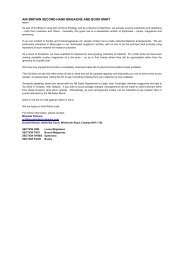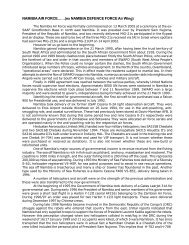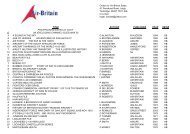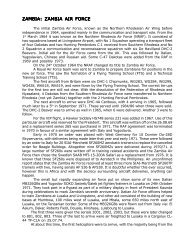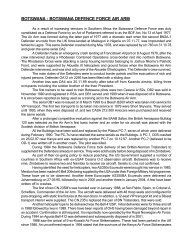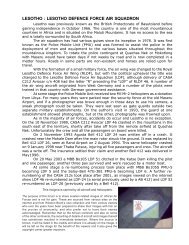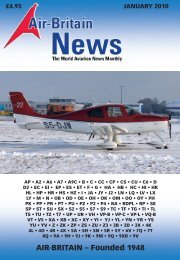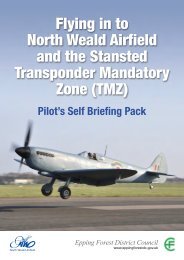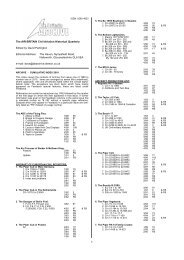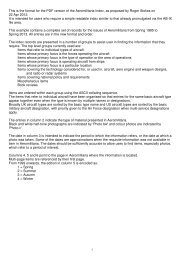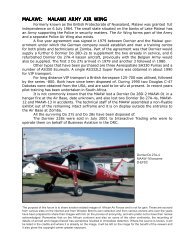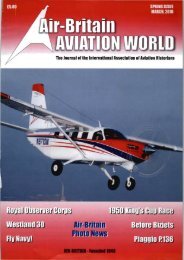The AIR-BRITAIN Militarv Aviation Historical Quanerlv
The AIR-BRITAIN Militarv Aviation Historical Quanerlv
The AIR-BRITAIN Militarv Aviation Historical Quanerlv
You also want an ePaper? Increase the reach of your titles
YUMPU automatically turns print PDFs into web optimized ePapers that Google loves.
15Dec67 Remains sold to Ministry of Technology (used for<br />
ground trials).<br />
22Jan69 Struck off Charge after making 141 flights.<br />
May 1974 Allotted to the RAF Museum, but in May 1978<br />
loaned to the Royal Navy Engineering College at<br />
Manadon as an instructional airframe (numbered<br />
A2619) . It was then loaned to the School of Aircraft<br />
Handling at RNAS Culdrose from 11 Apr78 (marked<br />
as 'SAH-6') before moving to storage at Carding ton<br />
in Feb94 and then to display at the Cosford<br />
Aerospace Museum.<br />
XS696<br />
05Mar65<br />
24Mar65<br />
01 Apr65<br />
First flight.<br />
Allotted to TES West Raynham.<br />
Caught fire on take-off at West Raynham and<br />
destroyed. sac same day as Cat.5(c). <strong>The</strong><br />
accident happened on its tenth flight.<br />
Below: Seven of the TES Kestrels on their flight line at<br />
RAF West Raynham during September 1965, wearing the final<br />
digit of their individual serial numbers as codes.<br />
(Central Press Photos via Phil Butler)<br />
Bot1om: XV·6A 64-18262 in the external display line-up at the<br />
US Air Force Museum at Wright-Patterson Air Force Base on<br />
30July1974. (Phil Butler1C71319)<br />
Aeromilitaria - Winter 2010<br />
Chris Farara kindly made some comments on my earlier<br />
article on the P .1127 prototypes, a digest of which<br />
appears below:<br />
On page 51 of the Summer issue, the photo of XP980 shows<br />
that a Harrier wing has been fit1ed for the trials that it was<br />
being used for. On page 52, it should be stated that MWDP<br />
funding was only provided for the Bristol engine, not the<br />
P.1127 airframe; it should also be stated that all Hawker<br />
development flying was carried out at Dunsfold, and the work<br />
at Bedford was research being carried out by the RAE. <strong>The</strong><br />
photo showing the ram-air turbine should have stated that this<br />
was always exposed when the engine was shut down, as it<br />
relied on positive pressure in the flying control circuit, provided<br />
by the running engine. <strong>The</strong> lower photo on page 52 shows<br />
XP831 having 'inflated'-shape intake lips, while XP836 has the<br />
'deflated' shape, with XP831 being dedicated to low-speed<br />
and XP836 to high-speed testing, these shapes being most<br />
appropriate for their intended flight envelopes. <strong>The</strong> photographs<br />
on pages 51 and 53 show the inflatable lips installed,<br />
while those on page 54 show alternative metal types, with<br />
those on XP984 being the finalised type, as used on the<br />
Kestrels. <strong>The</strong> inflatable type was abandoned, being liable to<br />
tearing in certain flight conditions. Finally, the crash of XP831<br />
at Paris was due to rotation of the air nozzles because of a<br />
malfunction, leading to a modification to the control valve to<br />
prevent any recurrence. Although the malfunction might have<br />
been caused by 'FaD', this was never proved.<br />
151




